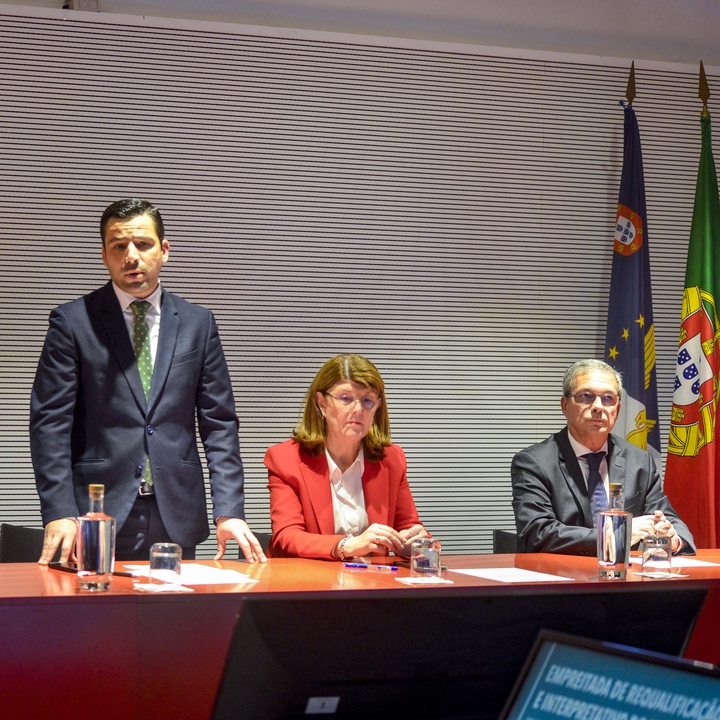Text size:
News

Regional Government of the Azores starts the construction work of the Monte da Guia Pedestrian and Interpretive Circuit
March 7, 2023
The Regional Secretary for the Environment and Climate Change, Alonso Miguel, and the Regional Secretary for Tourism, Mobility and Infrastructures, Berta Cabral, consigned on Monday the “Requalification of the Monte da Guia Pedestrian and Interpretive Circuit, Faial island – Visitation Support Area”, awarded to the company Afavia – Engenharia e Construções Açores S.A., with a construction period of 90 days and representing an investment of about 70 thousand euros.
The event took place at the Luís da Rocha Monteiro Auditorium on Faial island and was attended by the Mayor of Horta, Carlos Ferreira, as well as the representative of Afavias - Engenharia e Construções Açores, S.A., Pedro Brito.
For Alonso Miguel, this is a priority work: “Monte da Guia is a central landscape element of the city of Horta, in the life of the Faial inhabitants and for those who visit us, as a recreational and tourist site, with a marked historical, cultural and natural value, and, therefore, a fundamental part of local and regional development, which the Regional Government of the Azores recognizes as a priority to conserve, promote and enhance,” he said.
Monte da Guia has about 74 hectares and is part of the Faial Nature Park, with various protection statuses, given its landscape, biodiversity and geodiversity values, such as Protected Landscape Area and Geosite of the Azores UNESCO Global Geopark.
It is also covered by the Monte da Guia Special Area of Conservation (SAC), within the Natura 2000 network, besides being the central point of the Canal Faial-Pico/Sector Faial Protected Area for Resource Management.
“Evidently, these singularities make this Natural Monument a unique place and an authentic visiting card of the island of Faial and of the Region, a target of enormous demand for visitation and growing tourist pressure, which should be requalified, ordered and protected”, emphasizes the Regional Secretary.
This visitation support intervention includes the construction of a 315 m2 safe pedestrian circulation corridor, which extends from the small observation area of Porto Pim bay through the current Caldeirinhas viewpoint area, ending next to the trail access gate, allowing visitors to circulate safely and without restrictions or constraints and access to people with limited mobility.
The project also foresees a support area for cars, motorbikes and bicycles, eliminating the overload in the proximity of the bordering wall, as well as a set of complementary adaptations, such as the reconstruction of the wall, the replacement of the asphalt carpet by cobbled pavement in the pedestrian area, the placement of bollards outlining the meeting of the road area with the pedestrian area, the installation of bicycle supports and a guard to prevent direct access to the opening in the wall.
Alonso Miguel assured that this will be “a reduced intervention, which intends to respect and enhance the essence of the natural aesthetics that the space displays”, and announced a second phase of the intervention, under which the requalification of the Pedestrian and Interpretive Circuit and the creation of two viewpoints at the eastern top of Monte da Guia are planned.
The Regional Secretary also referred that creating an alternative trail is also under evaluation, which connects the viewpoints to be built at the eastern top to the Forte da Greta area, and the requalification of the amphitheatre, thus creating a new area to support visitors.
On the other hand, the Regional Secretary for Tourism, Mobility and Infrastructures, Berta Cabral, underlined the “symbolic moment as, after the centralisation of Public Works in this government department, this is the first time we are launching a joint project”.
“We currently have the advantage of cooperation, team spirit and joint work; to get here, a lot of work has already been done, a silent work in the regional directorates and regional secretariats,” she said.
Berta Cabral highlighted three dimensions of this intervention, namely, environmental preservation, the requalification of the space, and particularly the touristic dimension of the project.
And continued: “We give great emphasis to creating new visitation points to eliminate overload in certain attractions. With this, we also counteract the idea of massification created by greater pressure only in certain places”.
The Regional Secretary stated that it is “a strategic bet of this Government to create new visitation points, and this project meets the concern and orientation” of the Executive.

